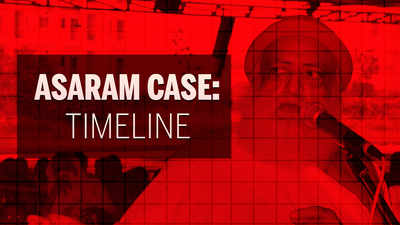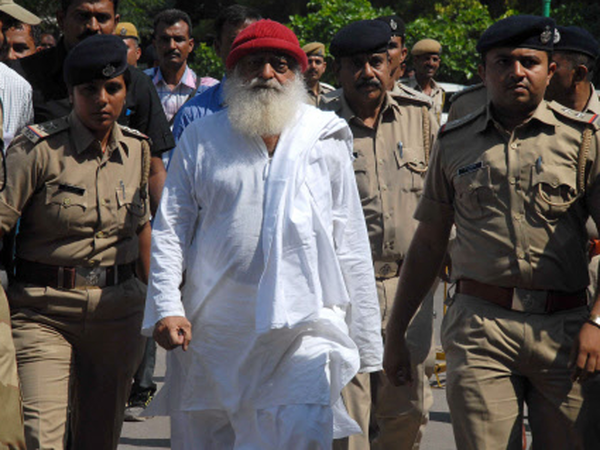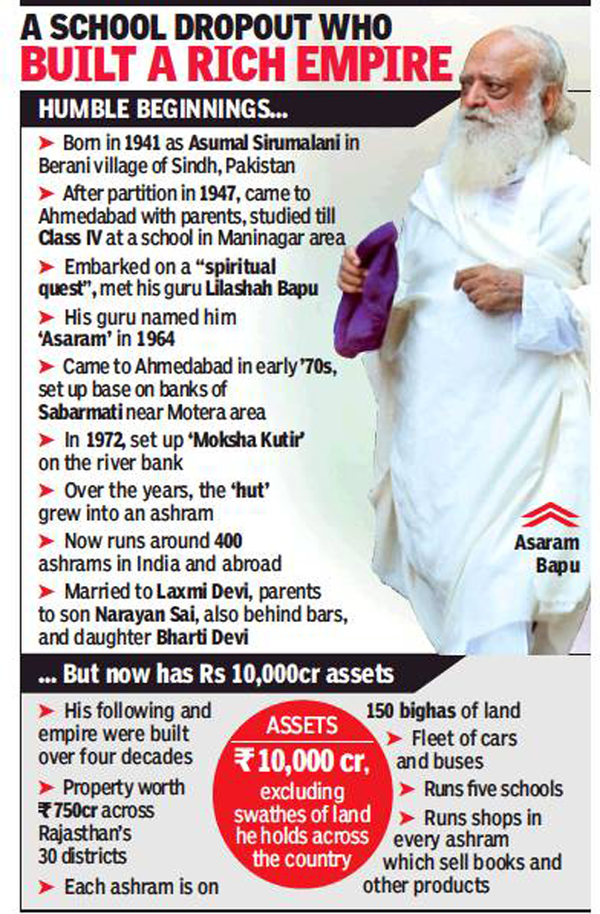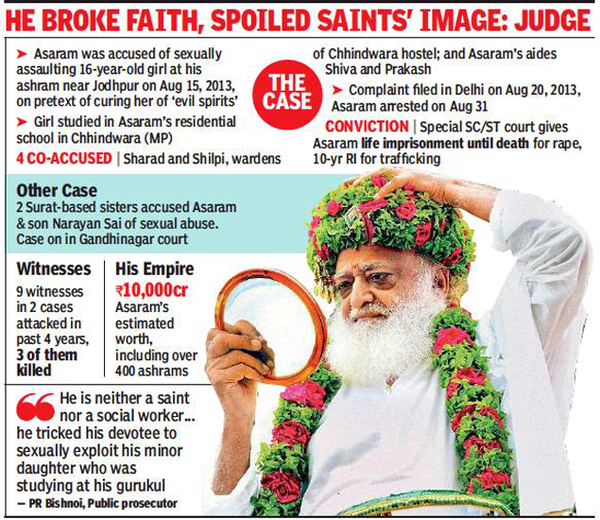- News
- India News
- Asaram 'Bapu Maharaj': From ghetto boy to godman to jailbird
Trending
This story is from April 26, 2018
Asaram 'Bapu Maharaj': From ghetto boy to godman to jailbird
Just after Partition, Thaumal Harpalani moved from Berani village in Pakistan’s Sindh with his wife Menhgiba and son Asumal to Ahmedabad. What followed was the typical story of survival in a refugee ghetto. They lived in the Sardarnagar area, where most Sindhi refugee families were resettled.

Key Highlights
- Asumal, now know as Asaram, spent most of his childhood in Ahmedabad's Sardarnagar, where he helped his father with timber & coal businesses
- Asumal ran away when he was 23 & reached an ashram in Bharuch, run by Lilasha Maharaj who named him ‘Sant Shri Asaram Bapu Maharaj’
- At his peak, Asaram reportedly ran an empire worth thousands of crores, with over 400 ashrams in India & abroad
AHMEDABAD: Just after Partition, Thaumal Harpalani moved from Berani village in Pakistan’s Sindh with his wife Menhgiba and son Asumal to Ahmedabad. What followed was the typical story of survival in a refugee ghetto. They lived in the Sardarnagar area, where most Sindhi refugee families were resettled.
Asumal helped his father with his timber and coal businesses in Maninagar and then at a grain shop in the Kalupur area of the city.When he was 10, his father died, but he still did his bit for the family business. But when he was 15, Asumal ran away.
He reached an ashram in Bharuch, run by Lilasha Maharaj, but the maharaj convinced him to go back home. Which he did, but eight years later, Asumal, then 23, ran away again. This time, Lilasha accepted him as a disciple and named him ‘Sant Shri Asaram Bapu Maharaj’. This was October 1964.
Also read: How Jodhpur police kept Asaram supporters at bay

As his popularity soared, so did his fortunes. At his peak, Asaram — now 77 — reportedly ran an empire worth thousands of crores of rupees, with over 400 ashrams in India and abroad.
But things started changing in 2008. In July, two boys —Dipesh and Abhishek Vaghela — went missing from the Motera Ashram. Their mutilated bodies were found from the Sabarmati riverbed a few days later. There were allegations that black magic was being practised in the ashram.

Narendra Modi, then Gujarat’s chief minister, set up the Justice D K Trivedi Commission to probe the boys’ deaths. Then, five years later, in August 2013, a 16-year-old girl accused Asaram of sexually assaulting her at the Jodhpur ashram.
In December the same year, Asaram’s son, Narayan Sai, was arrested on charges of raping two sisters from Surat, who alleged that Narayan Sai and his father had allegedly raped them at the Asaram ashram in the mid-2000s. The unravelling had started.

Slowly, many more facts came to light, especially the kind of wealth the godman had amassed. When Surat police raided the home of one follower, Prahlad Keswani, in January 2015, they recovered 42 gunny bags full of documents relating to investments worth Rs 2,500 crore in real estate, bank deposits and shares, all allegedly belonging to Asaram.
According to a chargesheet filed by Gujarat police, his empire was worth Rs 5,000 crore by 2008.

Asumal helped his father with his timber and coal businesses in Maninagar and then at a grain shop in the Kalupur area of the city.When he was 10, his father died, but he still did his bit for the family business. But when he was 15, Asumal ran away.
He reached an ashram in Bharuch, run by Lilasha Maharaj, but the maharaj convinced him to go back home. Which he did, but eight years later, Asumal, then 23, ran away again. This time, Lilasha accepted him as a disciple and named him ‘Sant Shri Asaram Bapu Maharaj’. This was October 1964.
Also read: How Jodhpur police kept Asaram supporters at bay
Seven years later, in 1971, Asaram returned to Ahmedabad. He had two children by then -- Narayan Sai and Bharti Devi. His spiritual discourses gradually gained popularity among the tribal people of Panchmahal and Bharuch districts in Gujarat and the Hindi-speaking people from north India. During a 2001 diksha ceremony in Ahmedabad, more than 20,000 devotees attended the ‘satsangh’ function.

As his popularity soared, so did his fortunes. At his peak, Asaram — now 77 — reportedly ran an empire worth thousands of crores of rupees, with over 400 ashrams in India and abroad.
But things started changing in 2008. In July, two boys —Dipesh and Abhishek Vaghela — went missing from the Motera Ashram. Their mutilated bodies were found from the Sabarmati riverbed a few days later. There were allegations that black magic was being practised in the ashram.

Narendra Modi, then Gujarat’s chief minister, set up the Justice D K Trivedi Commission to probe the boys’ deaths. Then, five years later, in August 2013, a 16-year-old girl accused Asaram of sexually assaulting her at the Jodhpur ashram.
In December the same year, Asaram’s son, Narayan Sai, was arrested on charges of raping two sisters from Surat, who alleged that Narayan Sai and his father had allegedly raped them at the Asaram ashram in the mid-2000s. The unravelling had started.

Slowly, many more facts came to light, especially the kind of wealth the godman had amassed. When Surat police raided the home of one follower, Prahlad Keswani, in January 2015, they recovered 42 gunny bags full of documents relating to investments worth Rs 2,500 crore in real estate, bank deposits and shares, all allegedly belonging to Asaram.
According to a chargesheet filed by Gujarat police, his empire was worth Rs 5,000 crore by 2008.

End of Article
FOLLOW US ON SOCIAL MEDIA










